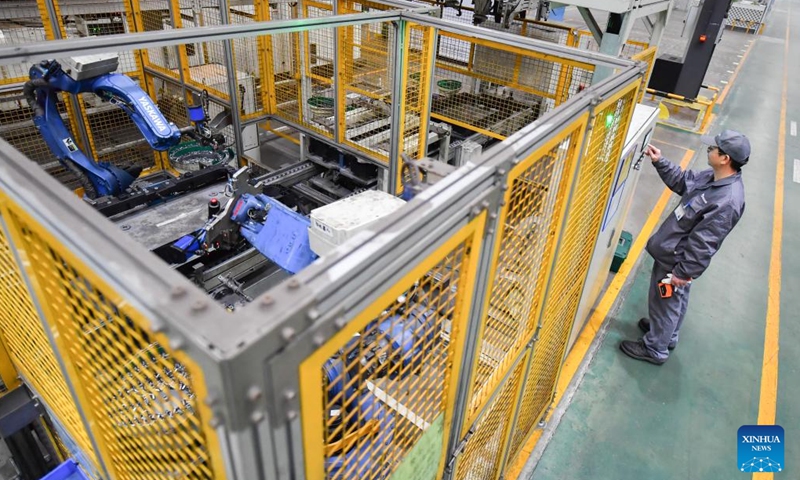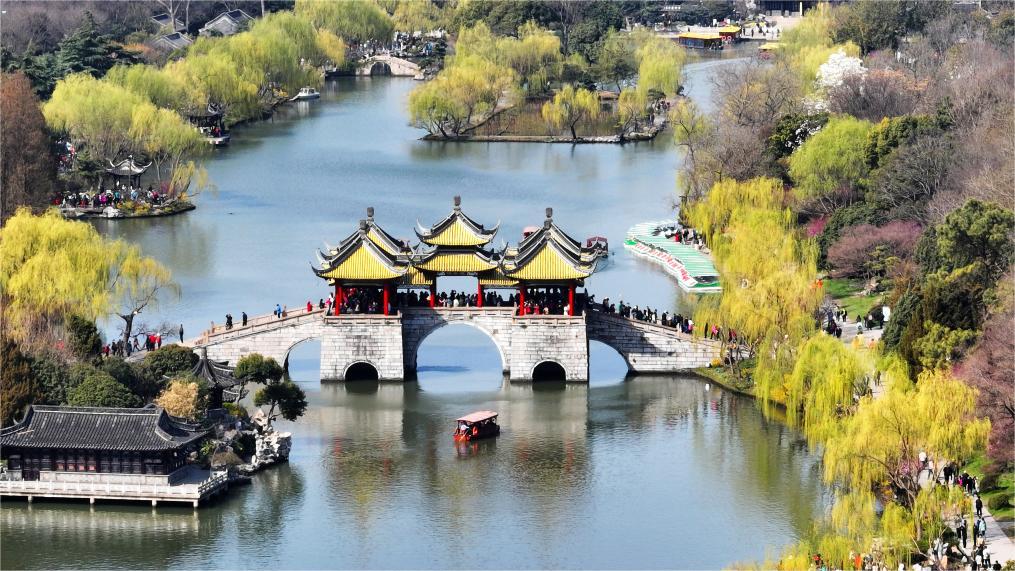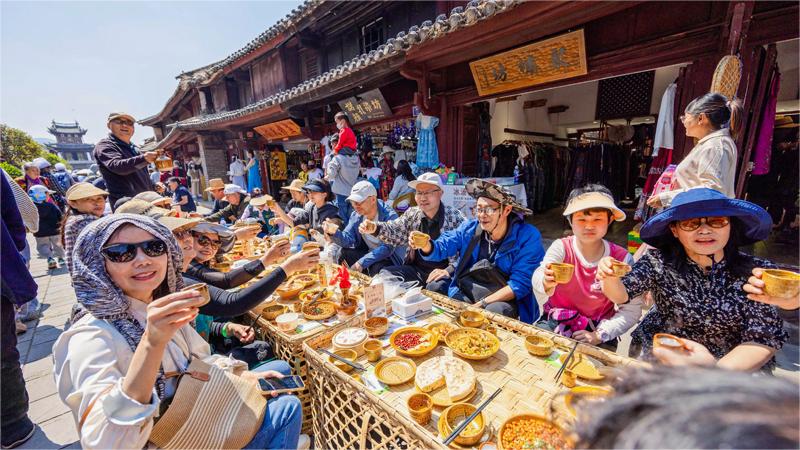Xiconomics in Practice: Xi's inspection tour highlights critical role, vast potential of China's central region

A staff member works at an auto parts factory in Liuyang City, central China's Hunan Province, Feb 1, 2024. Photo: Xinhua
Chinese President Xi Jinping, during an inspection tour to Central China's Hunan Province this week, called on Hunan to follow a realistic and pragmatic approach to write its own chapter in advancing Chinese modernization and called for solid efforts to further energize the country's central region at a higher starting point.
This is the first local inspection tour made by Xi, also general secretary of the Communist Party of China (CPC) Central Committee and chairman of the Central Military Commission, after the national two sessions. The trip underscored the critical role of Central China in the country's pursuit of high-quality development as well as its vast potential in forming new quality productive forces, economists said.
The rise of China's central region and continuous opening-up will also provide greater opportunities for the world, as it sends an increasing number of high-quality products to overseas markets and brings in many multinational businesses to invest and expand in the region, economists noted. Some foreign businesses also said they are committed to expanding investment in the region and across the country.
Region in spotlight
During the inspection tour from Monday to Thursday, Xi called on Hunan to stay committed to reform and innovation and follow a realistic and pragmatic approach to write its own chapter in advancing Chinese modernization, the Xinhua News Agency reported on Thursday.
On Wednesday, Xi chaired a symposium on further energizing the central region in the new era, calling for solid efforts to further energize the central region at a higher starting point. In his speech, Xi highlighted the central region's pivotal role as the country's important grain production base, energy and raw material base, modern equipment manufacturing and high-tech industry base, and comprehensive transportation hub, according to Xinhua.
China's central region includes six provinces - Shanxi, Anhui, Jiangxi, Henan, Hubei and Hunan, and accounts for one-tenth of the country's land area, more than one-fourth of the population, and more than one-fifth of the country's total GDP. The region plays a critical role in China's pursuit of Chinese modernization. In 2023, the central region's combined GDP reached 26.99 trillion yuan ($3.75 trillion), with a growth rate of 4.9 percent, slightly lower than the country's GDP growth rate of 5.2 percent, according to official data.
At the symposium, Xi said that since the previous symposium on energizing the central region was held five years ago, the region's development has reached a higher level. He also noted that further energizing the central region still faces many difficulties and challenges that require practical research to solve them.
Specifically, the Chinese president called for more efforts to push forward industrial innovation led by scientific and technological innovation, and actively cultivate new quality productive forces. He also called for forward-looking plans for future industries and a faster pace in modernizing the industrial system underpinned by advanced manufacturing.
The top leader's remarks and the inspection tour in Hunan not only underscored the central region's great importance, but also highlighted its vast potential, as the country moves swiftly to develop new quality productive forces and high-quality development, economists said.
"From the perspective of China's coordinated regional development strategy, the rise of the central region carries great significance for the pursuit of Chinese modernization," Cao Heping, an economist at Peking University, told the Global Times on Thursday. "It can fully leverage its comparative advantages to cultivate and strengthen advanced manufacturing industries, and seize opportunities to cultivate and develop new quality productive forces."
Coordinated regional development is a national strategy in China. This year's Government Work Report, which was adopted at the two sessions earlier this month, also vowed to pursue better coordinated regional development. It said China will thoroughly implement the strategies for accelerated rise of the central region. At the two sessions, new quality productive forces also became a buzzword.
During the inspection tour in Hunan, Xi also learned about local efforts to accelerate the development of new quality productive forces and promote high-standard opening-up.
With advantages in areas such as clean energy, raw materials as well as massive computing capacity, the central region has great advantage in developing new emerging industries, according to Hu Qimu, a deputy secretary-general of the digital-real economies integration Forum 50.
"The Fourth Industrial Revolution, led by digitalization, has changed the traditional layout of industries, which usually focuses on the coastal regions. Now, the inland regions also have some advantages in fostering high-end industries," Hu told the Global Times on Thursday.
Vast potential
Various cities in the central region have already made great strides in developing critical industries such as automobiles, digital information and equipment manufacturing, and have formed a number of industrial clusters with main business income exceeding 100 billion yuan.
Changsha, for example, has developed six manufacturing industry clusters with an output value of more than 100 billion yuan, covering engineering machinery, automobiles and parts, new materials and digital information, according to media reports. Hefei, the provincial capital of Anhui, has also become a major breeding ground for high-tech companies in areas such as quantum computing and artificial intelligence, which has become globally known as the "Hefei model."
High-level opening-up is also a top priority for the development of the central region. At the symposium on Wednesday, Xi urged the region to promote deep reforms and high-level opening up in a coordinated manner in its efforts to grow into a more competitive inland pacesetter for opening up. Also during the inspection tour, Xi reaffirmed the nation's commitment to opening-up and developing new quality productive forces, as he visited BASF Shanshan Battery Materials Co, a joint venture (JV) between German chemical giant BASF and Chinese lithium battery materials maker Ningbo Shanshan Corp.
Economists said the central region also has great potential in both expanding foreign trade and attracting global investments.
"While various central provinces have great advantages in developing industrial clusters, they are also vigorously promoting the construction of platforms for opening-up and exploring new models of developing an open economy," Cao said.
By joining various national opening-up initiatives such as the Belt and Road Initiative, the central region has also seen steady rise in foreign trade. In 2023, the central region's exports and imports reached 3.62 trillion yuan, with its proportion of the national total surging 3.7 percentage points from that of 2012. Many cities in the region have joined the China-Europe Railway Express, with Henan's overseas freight train network alone covering over 140 cities in 40 countries in Europe and Asia.
The region is also drawing increasing foreign investments, especially in high-tech areas. In 2023, Hubei saw a foreign investment of more than 19 billion yuan, up 11.39 percent year-on-year and ranking the top among central provinces. Foreign investment in high-tech fields accelerated, with information transmission, software and information technology services growing by 45.66 percent, and high-tech manufacturing growing by 76.35 percent, according to official data.
With greater efforts to improve business environment and attract foreign investment, many multinationals like BASF are expanding investments not only in the central region but across China.
"BASF Shanshan Battery Material Co is confident and committed to further developing our business in the new-energy industry. We will continuously leverage our innovation capabilities, and strengthen the collaboration with local and international partners, contributing to the high-quality development of the lithium cathode active material industry as well as China's 'dual carbon' targets," Peng Wenjie, executive deputy general manager, COO and CTO of BASF Shanshan, told the Global Times.
Photos
Related Stories
Copyright © 2024 People's Daily Online. All Rights Reserved.









